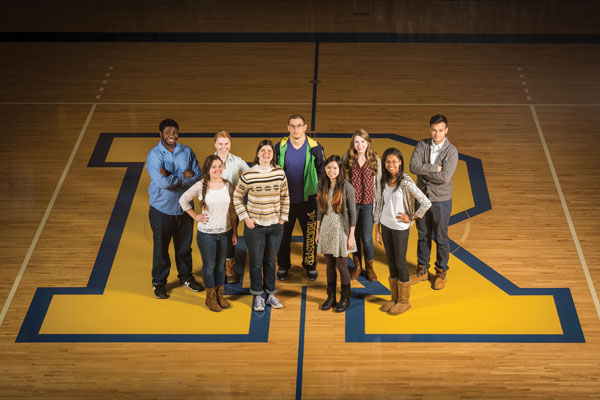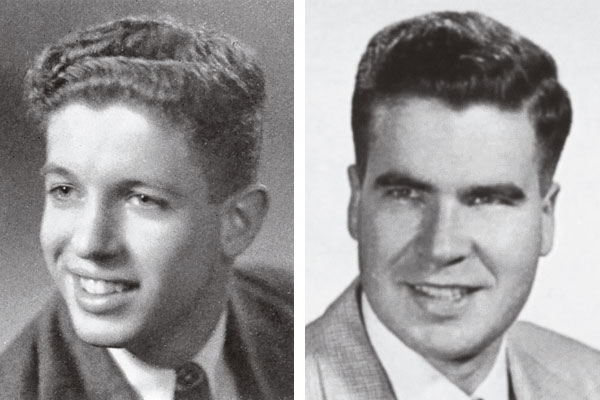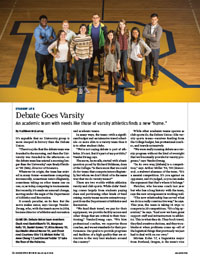In Review
 GAME ON: Debate Union team members (back row) Daniel Bamfo ’19, Margeaux Kelly ’19, Daniel Gomez ’17, Kitra Moeny ’19, Gazi Mahir Ahmed Naven ’19, and (front row) Courtney Otto ’19, Miriam Kohn ’17, Anne Cheng ’17, and Emoni Tedder ’17 take the floor of the Palestra. (Photo: Adam Fenster)
GAME ON: Debate Union team members (back row) Daniel Bamfo ’19, Margeaux Kelly ’19, Daniel Gomez ’17, Kitra Moeny ’19, Gazi Mahir Ahmed Naven ’19, and (front row) Courtney Otto ’19, Miriam Kohn ’17, Anne Cheng ’17, and Emoni Tedder ’17 take the floor of the Palestra. (Photo: Adam Fenster)It’s arguable that no University group is more steeped in history than the Debate Union.
“There’s a joke that the debate team was founded in the morning, and then the University was founded in the afternoon—so the debate team has existed a morning longer than the University,” says Brady Fletcher ’08 (MA), director of forensics.
Whatever its origin, the team has existed in many forms—sometimes competing intramurally, sometimes intercollegiately; sometimes taking on other teams one on one, or, as today, competing in tournaments. But recently, it’s made an unusual change, moving under the aegis of the Department of Athletics and Recreation.
It sounds peculiar, on its face. But the move makes sense, says George VanderZwaag, who, with the team’s move in 2014, became director of athletics and recreation and academic teams.
In many ways, the team—with a significant budget and an intensive travel schedule—is more akin to a varsity team than it is to other student clubs.
“We’re not saying debate is part of athletics. It’s not. But it’s part of my portfolio,” VanderZwaag says.
The move, he recalls, started with a basic question posed by Richard Feldman, dean of the College: “Is there more that we could do for teams that compete intercollegiately, but whom we don’t think of in the same way that we do varsity teams?”
There are two worlds within athletics: varsity and club sports. While clubs’ funding comes largely from students paying dues and performing other kinds of fund raising, varsity teams receive extensive support from the Department of Athletics and Recreation.
“We fund their travel, we pay for their equipment, we provide facility access and other things that are critical to their functioning,” VanderZwaag says. “We hire professional coaches, we supervise those coaches, and we set standards for their performance. Our goal is to provide programs and facilities of a high quality that are attractive to the very best students around the country.”
While other academic teams operate as club sports do, the Debate Union—like varsity sports teams—receives funding from the College budget, has professional coaches, and travels extensively.
“We were really running debate as a varsity program without the kind of oversight that we’d normally provide for varsity programs,” says VanderZwaag.
“In its own way, [debate] is a competition,” says Arthur Miller ’56, ’08 (Honorary), a stalwart alumnus of the team. “It’s a mental competition. It’s you against an opponent, and it’s judged, so you can make the argument that that’s where it belongs.”
Fletcher, who became coach last year but who has a long history with the team, says the new arrangement is working well.
“The new relationship has served what we do in a really constructive way,” he says. This year, the team is taking 18 trips to compete in 20 competitions. “It’s a big operation,” he says. “And now we have great support staff and infrastructure in athletics. This is what they do. They book travel, they find creative solutions, and they troubleshoot when problems come up—all of the logistical things that previously we just had to deal with on our own.”
Miriam Kohn ’17, a linguistics major from Portland, Oregon, is the team’s vice president. She calls the move “a positive change. We see more resources, and we can travel with more people to more destinations.”
Team members compete around the country and, increasingly, the world. Last year, destinations included Alaska and Serbia, as well as Hungary. This spring, they’ll be going back to Budapest and to the Netherlands. Such travel is made possible in part with the aid of Miller and Martin Messinger ’49, both longtime benefactors of debate at Rochester who are providing endowed support for the team.
While the team competes energetically, its hallmark is its openness.
“First among our values is that we want to be an open, accessible place to any student who wants to have experience in competitive debate,” says Fletcher. “We think debate has enormous pedagogical value, and—unlike other debate teams with more rigid barriers or standards for being a member—we want to be there for you if you want to debate.”
That dedication to a welcoming environment complicates the comparison of the Debate Union to a varsity team for the simple reason that “varsity” and “novice” are technical terms in debate—and Rochester’s team is committed to maintaining a novice focus.
Yet treating the Debate Union like a varsity team actually enhances the program’s ability to deliver the novice experience, Kohn points out.
“We want to be sure debate is not just for those who happen to have spare funds to travel,” she says.
Kohn competes in both of the main forms of debate, forms that are in some ways comparable to a sprint and a marathon: British Parliamentary debate, which allots competitors just 15 minutes to prepare their arguments; and policy debate, in which competitors extensively research and debate one topic over the course of an entire season.
Kohn says she comes from a family of “loud, strong-willed, self-confident people, for better or worse. I grew up with spirited discussions around the dinner table.”
She began debate in high school, and when she arrived at Rochester, saw a flyer for the team and thought, “Why not?”
While the move to the athletics department is working well, VanderZwaag says he wouldn’t expect to see the structure replicated at other institutions.
“It’s a product of who we are and our circumstances,” he says. “It just seemed to make sense here.”


